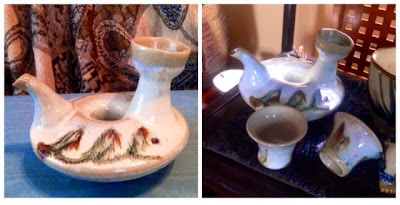http://www.puckergallery.com/pdf/Hamada%203G%202011.pdf
http://www.studio-pots.com/MM1%20ONLINE%20CATALOGUE.PDF
SHIMAOKA TATSUZO (島岡達三) 1919-2007
Living National Treasure (LNT Ningen Kokuho 1996) Mashiko, for his cord-marked ceramics with slip inlay. He apprenticed with Shoji Hamada.
These three cups are unmarked but by every indication are the work of Shimaoka Tatsuzo. Although most of his works are marked with the タ mark, according to an expert in Japanese ceramics (RY) there are pieces, especially those of his earlier years, that are unmarked. These are most likely from the 1960's -1970's.
See:
HAMADA SHINSAKU (second son of Shoji Hamada) 1929~
There was no box with this when I bought it but the style, motif and nuka glaze is classic Shinsaku.
HAMADA MON-GAMA
(Most likely-no box or mark)
MURATA GEN (村田元) 1904-1988
Murata Gen is one of the greatest Mashiko potters. He studied with Hamada Shoji.
HASEGAWA TSUGIO (長谷川つぎお)
 | ||
| Mashiko-yaki tea bowl with Hakeme brushwork with pool of green glaze ************************************ UNMARKED or GENERIC MASHIKO I found this flask in a second hand shop, without a mark, box or identification papers. Interstingly enough I found matching cups in another second hand shop. Because of the color and similar styles in the pottery of Okinawa I originally placed them in that category. I have recently discovered similar "ring" shaped flasks categorized as Mashiko, one with the box with Mashiko written on it. I will now place this flask and matching guinomi in the Mashiko category. It is an unusual shape even for Mashiko. I hope to find out more about this style and will post when I know more. I do know that Mashiko potters, especially Shoji Hamada, did draw influence from Tsuboya yaki, the pottery of Okinawa.
Murasawa Hiroshi Kiln 村澤浩
https://jptca.org/Seto_Hiroshi/?fbclid=IwAR1ggveL-q7oak1hg7pR7a1QYsVpkKpQfQqa18pbKhWMcqMeCGd4-y_WzgE Hiroshi Seto Seto Hiroshi Ceramic artist craftsman Born in Tokushima City, Tokushima Prefecture in 1941. In 1964, graduated from Kyoto City University of Arts, Department of Crafts, Department of Ceramics. Built in 1965 in Mashiko, Tochigi Prefecture. From 1972 to 1973, he was invited to the United States as a lecturer at Indiana University and Colorado State University. Since 1974, he has exhibited in domestic and international solo exhibitions and public exhibitions (invited artists) using striped patterns. He passed away in 1994. ************** ******************
|























No comments:
Post a Comment